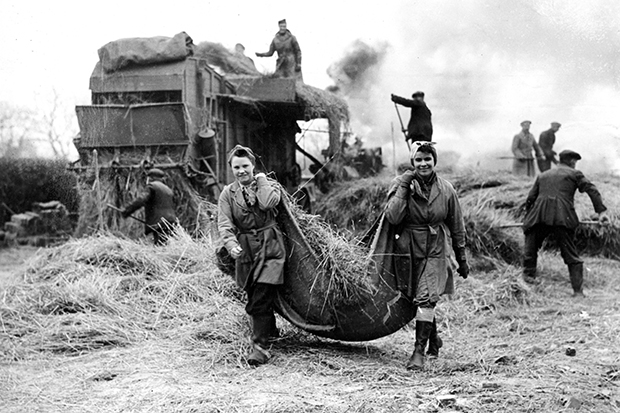This big, bristling, deeply-furrowed book kicks off with a picture of the British countryside just before the second world war. Apparently we then grew only 30 per cent of our food, horses did most of the work and a lot of the land, criss-crossed by empty roads featuring the occasional pony trap, had been abandoned to weeds and brambles.
Move on a year or two and millions of acres had been brought under the plough. Tennis courts, golf courses, railway embankments, school playing fields and even the lawns of large houses had been turned into vegetable plots or corn fields. Barbed wire blocked the beaches, church bells only rang to warn of imminent invasion and ornamental church gates had been carted off to be turned into tanks. Armed vehicles of every description clogged the roads and a reddish gold sky ten miles away would indicate that a nearby city was in flames.
Sounds terrible — but worse was to come. Runways, control towers, hangars and Nissen huts soon littered the land. Badger setts were turned into subterranean lairs, while stately homes were given over to evacuees — or vital government offices. Glorious Chatsworth had 21 schoolgirls sleeping in its state drawing room and less-than-glorious, ‘Lavatory Gothic’ Bletchley Park became a top-secret code-breakers’ workshop. Further afield, on a tiny Scottish island, the authorities were testing the potency of anthrax spores which could be used for a biological attack on the enemy.
Yes, war is ghastly; but Duff Hart-Davis explains how we responded to the enemy machine-gunning herds of our precious cattle — by feasting off nettle soup, baked hedgehog, sizzled frogs’ legs and the infamous Woolton pie (made of swedes, carrots and turnips).
We also kept going at our outdoor sports. The Derby continued to be run. No less than 4,500 brace of grouse were shot at Bolton Abbey in 1942; the Duke of Beaufort carried on hunting with ‘astonishing single-mindedness’ and the Duke of Westminster pursued his Eaton Hall rabbits with a pack of dachshunds. Soon the King himself — he and the Queen had their own ration books — had invited local troops to fish in the waters of Windsor Park…
This is all very upbeat, but it’s a pity the author bothers to tell us that John Betjeman was a poet while making no mention of Rudolf Hess parachuting to the Duke of Hamilton’s estate on a solo peace mission. All is redeemed when we learn how fast evacuees and land girls adapted to country life. ‘Sheer paradise’ is how one of them put it. Part of the fun was the bonds they formed, not only with American soldiers — ‘One Yank and they’re off!’ went the popular wartime joke about a girl’s knickers — but also with Italian and German prisoners of war, many of whom came from farming families and turned out to be ‘decent enough people … certainly hard workers’. It’s nice to know that Germans ploughing our fields consoled themselves with a gin-like spirit made from potatoes and that their Italian counterparts even built a chapel for themselves on the Orkney island of Lamb Holm, still in good repair 70 years later.
Such revelations brighten up this book and act as a healthy counterblast to the horrors elsewhere.
Got something to add? Join the discussion and comment below.
Get 10 issues for just $10
Subscribe to The Spectator Australia today for the next 10 magazine issues, plus full online access, for just $10.
Available from the Spectator Bookshop, £16, Tel: 08430 600033
You might disagree with half of it, but you’ll enjoy reading all of it. Try your first month for free, then just $2 a week for the remainder of your first year.














Comments
Don't miss out
Join the conversation with other Spectator Australia readers. Subscribe to leave a comment.
SUBSCRIBEAlready a subscriber? Log in